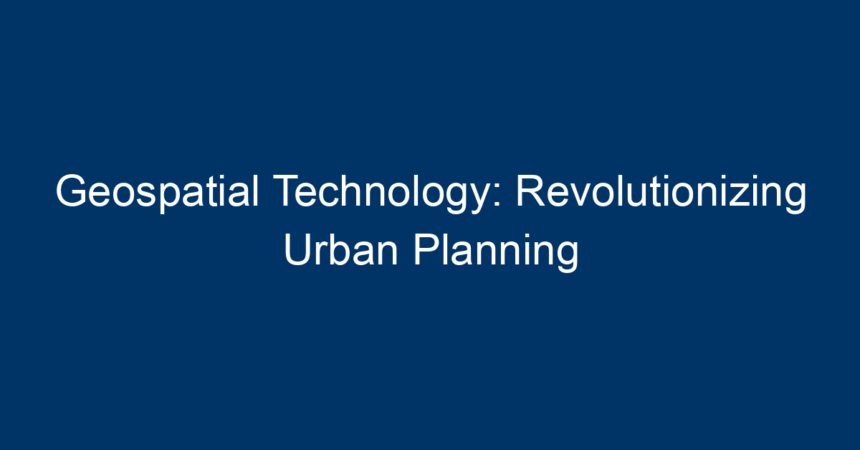In an era where urban landscapes are expanding at breakneck speeds, the need for effective urban planning is more critical than ever. Enter geospatial technology—an innovative tool set that combines geographical information systems (GIS), satellite imagery, remote sensing, and global positioning systems (GPS) to analyze spatial data. By harnessing this technology, city planners can visualize complex data, facilitate informed decision-making, and design sustainable urban environments. In this article, we will explore how geospatial technology is revolutionizing urban planning, enhancing efficiency, and addressing the challenges of modern cities.
Understanding Geospatial Technology
What is Geospatial Technology?
Geospatial technology refers to a suite of tools and software designed to collect, visualize, and analyze geographic data. It encompasses:
- Geographical Information Systems (GIS): Software that allows for mapping and analysis of spatial data.
- Remote Sensing: The use of satellite or aerial imagery to collect information about the earth’s surface.
- Global Positioning Systems (GPS): A technology that determines the precise location of an object.
Key Components of Geospatial Technology
-
Data Collection and Integration: The process begins with data collection from various sources, including sensors, surveys, and satellite imagery. This data is then integrated into GIS platforms for analysis.
-
Visualization: GIS tools enable urban planners to create detailed maps and models that visually represent data, making it easier to interpret complex information.
-
Analysis: Advanced analytical tools help planners assess patterns, trends, and potential issues, allowing them to make data-driven decisions.
- Collaboration: Geospatial technology fosters collaboration among various stakeholders, including government agencies, private firms, and community organizations.
The Role of Geospatial Technology in Urban Planning
1. Enhanced Decision-Making
Geospatial technology transforms the decision-making process in urban planning by providing data-driven insights. Planners can quickly visualize demographic changes, land-use patterns, and infrastructure needs. For instance, by analyzing population density maps, planners can identify areas requiring new public services, such as schools or hospitals.
2. Sustainable Development
Urban areas face numerous sustainability challenges, such as traffic congestion, pollution, and inadequate green spaces. Geospatial technology aids in developing sustainable solutions by assessing environmental impacts and modeling future scenarios. For example, planners can evaluate the effects of new developments on local ecosystems and strategize to minimize adverse impacts.
3. Infrastructure Management
Managing urban infrastructure can be daunting without the right tools. Geospatial technology allows for effective infrastructure planning and maintenance. By tracking the condition of roads, bridges, and utilities through spatial data, cities can prioritize repairs, reducing costs and enhancing public safety.
4. Land Use Planning
Efficient land use planning ensures optimal space utilization in urban areas. Geospatial technology provides insights into current land use, zoning regulations, and potential development sites. Planners can analyze land availability, proximity to public transport, and environmental constraints to make informed land-use decisions.
Case Studies: Successful Implementation of Geospatial Technology in Urban Planning
1. Singapore: Smart Nation Initiative
Singapore has effectively integrated geospatial technology into its urban planning strategy. Through its Smart Nation initiative, the government employs real-time data analytics to manage traffic, public transport, and urban infrastructure. This use of geospatial technology has significantly reduced congestion and improved service delivery.
2. New York City: NYC OpenData
New York City’s commitment to transparency and data-driven governance is exemplified by its NYC OpenData platform. This initiative provides access to a wealth of geospatial data, enabling residents and planners to analyze city resources, assess neighborhood needs, and engage in informed discussions about urban development.
3. Barcelona: Urban Observatory
Barcelona’s Urban Observatory leverages geospatial technology to monitor urban dynamics and facilitate sustainable growth. By analyzing spatial data on mobility patterns, energy consumption, and public spaces, city officials can design more livable and resilient urban environments.
Challenges in Geospatial Technology Adoption
Despite its transformative potential, the adoption of geospatial technology in urban planning faces several challenges:
1. Data Privacy Concerns
As urban planners collect and analyze vast amounts of data, concerns about privacy and data security arise. Stakeholders must balance the benefits of data availability with the need to protect personal information.
2. Technical Expertise
Implementing sophisticated geospatial technology requires trained professionals with expertise in data analysis, GIS, and remote sensing. A shortage of skilled labor may hinder effective adoption in some regions.
3. Cost of Technology
The initial investment in geospatial technology can be substantial. Cities with limited budgets may struggle to acquire the necessary tools and training, creating disparities in urban planning capabilities.
Future Trends in Geospatial Technology for Urban Planning
1. Integration of AI and Machine Learning
The future of geospatial technology lies in the integration of artificial intelligence (AI) and machine learning. These technologies can enhance data analysis, predict trends, and automate decision-making processes, leading to more efficient urban planning.
2. Real-Time Data Utilization
The collection and analysis of real-time data will significantly influence urban planning. IoT devices and sensors can provide live updates on traffic patterns, air quality, and resource usage, enabling planners to adapt quickly to changing situations.
3. Citizen Engagement through Geospatial Tools
Engaging citizens in the planning process will become increasingly important. Platforms that allow residents to visualize and interact with geospatial data can foster community involvement, ensuring that urban development aligns with the needs and desires of local populations.
Conclusion: Actionable Insights for Urban Planners
The integration of geospatial technology into urban planning is not just a trend but a necessity for creating efficient, sustainable, and livable cities. Here are actionable insights for urban planners:
-
Embrace Data-Driven Decision Making: Utilize geospatial data to guide planning decisions, ensuring that strategies are informed by accurate information.
-
Invest in Training: Develop training programs for staff to ensure they can effectively use geospatial tools and interpret data.
-
Foster Collaboration: Encourage collaboration among stakeholders, including community members, to create inclusive planning processes.
-
Pilot Projects: Start with small-scale pilot projects that leverage geospatial technology to demonstrate its benefits and pave the way for broader implementation.
- Stay Updated on Technology Trends: Keep abreast of advancements in geospatial technology and incorporate new tools and practices to enhance urban planning processes.
By adopting these strategies, urban planners can harness the full potential of geospatial technology, revolutionizing the way cities are planned and developed in the 21st century.




